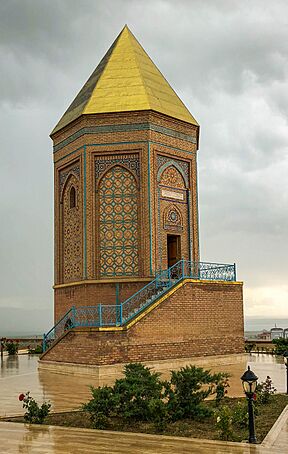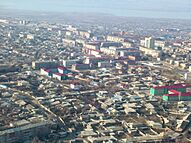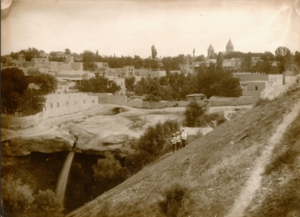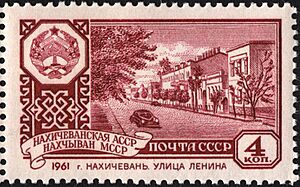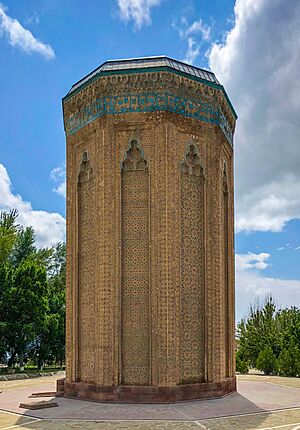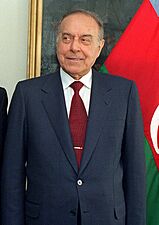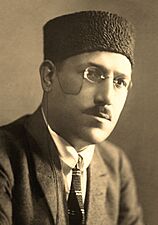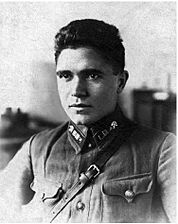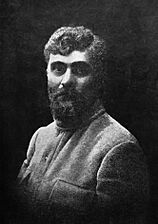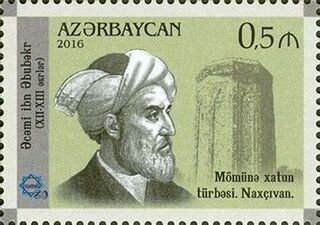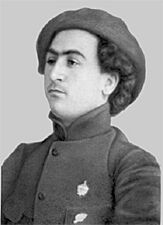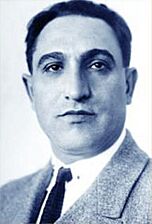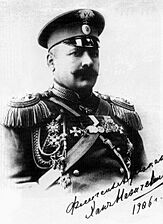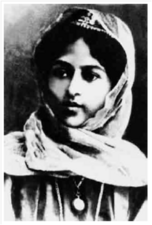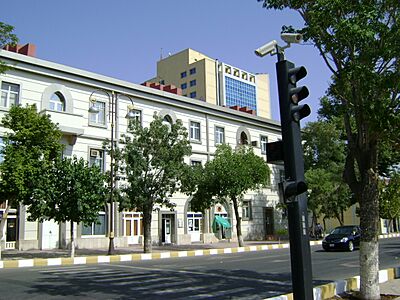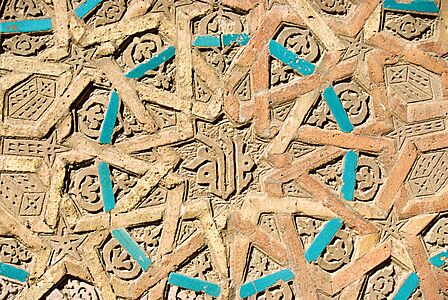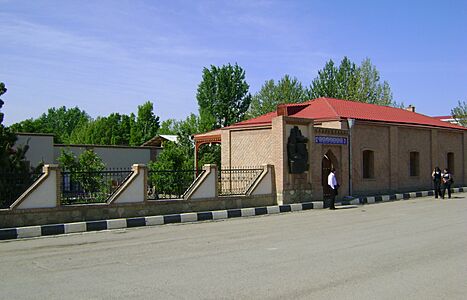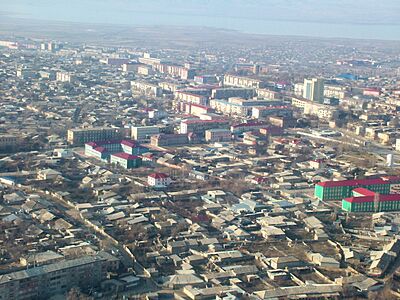Nakhchivan (city) facts for kids
Quick facts for kids
Nakhchivan
Naxçıvan
|
|
|---|---|
|
Noah's Mausoleum
Momine Khatun Mausoleum
Mausoleum of Huseyn Javid
Jame Mosque of Nakhchivan
Palace of Nakhchivan Khans
Nakhchivan Center Hospital
A street in Nakhchivan
Yusif ibn Kuseyir Mausoleum
Aerial view of Nakhchivan
Nakhchivan in Azerbaijan
|
|
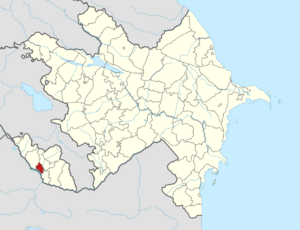 |
|
| Country | |
| Autonomous Republic | Nakhchivan |
| Area | |
| • Total | 190 km2 (70 sq mi) |
| Elevation | 873 m (2,864 ft) |
| Population
(2020)
|
|
| • Total | 94,500 |
| Demonym(s) | Nakhchivanly |
| Time zone | UTC+4 (AZT) |
Nakhchivan (Azerbaijani: Naxçıvan) is the capital city of the Nakhchivan Autonomous Republic. This republic is a special part of Azerbaijan. It is located about 450 kilometers (280 miles) west of Baku, Azerbaijan's main capital.
The city of Nakhchivan includes the main city area. It also has the settlement of Əliabad and several villages. These villages are Başbaşı, Bulqan, Haciniyyət, Qaraçuq, Qaraxanbəyli, Tumbul, Qarağalıq, and Daşduz. Nakhchivan is built on the hills of the Zangezur Mountains. It sits on the right side of the Nakhchivan River. The city is about 873 meters (2,864 feet) above sea level.
Contents
What's in a Name?
The official name of the city in Azerbaijani is "Naxçıvan." Its name is also spelled as Nakhjavan in Persian. In Russian, it's Nakhichevan', and in Armenian, it's Nakhijevan.
The city's name was first written down by Ptolemy. He was an ancient Greek scholar. In his book Geography, he called it Naxuana.
Some people believe the name Nakhchivan is linked to the story of Noah's Ark. They think it means "place of the first descent" or "first resting place." This is because it's believed to be where Noah landed after the great flood. He is said to have settled here after his ark landed on nearby Mount Ararat.
A Look at History
Early Times
According to Armenian stories, Nakhchivan was founded by Noah after the great flood. It is also believed to be where he died and was buried. The city was first mentioned in ancient writings as Naxuana.
In 363 AD, the city was destroyed by a Persian ruler named Shapur II. Its people were taken to Iran. Later, in 623 AD, Emperor Heraclius traveled through the city during a big war.
Medieval Period
In 650 AD, Arab armies attacked Nakhchivan. Later, in 705 AD, many local leaders were killed in churches in Nakhchivan.
Around 900 AD, Nakhchivan was briefly controlled by the Bagratid Kingdom of Armenia. But it was quickly taken over by another ruler. The city was also conquered by the Kingdom of Georgia in 1197.
In 1236, the Mongol Empire took over Nakhchivan. Later, merchants from Genoa traded in the city by 1280. The famous conqueror Timur also took the city in 1401.
Modern History

In 1503, a Persian ruler named Ismail I conquered Nakhchivan. Later, in 1603–1604, another Persian ruler, Abbas I of Persia, took it back from the Ottoman Empire. The city then became the capital of the Nakhichevan Khanate.
In 1828, the Russian Empire took control of the Nakhchivan Khanate. This happened after a treaty was signed. By 1896, Nakhchivan had about 7,433 people. Most of them were Azeri-speaking Muslims, and about one-third were Armenian Christians.
After the February Revolution in 1917, Nakhchivan saw many changes. It was controlled by different groups. In 1919, British soldiers occupied the city. It was even decided that Nakhchivan would be given to Armenia.
However, in March 1920, Turkish forces took over Nakhchivan. Then, Soviet Russia took control in July 1920. The city became part of the new Nakhchivan Autonomous Soviet Socialist Republic. Treaties in 1921 made Nakhchivan an autonomous territory. This meant it had its own rules but was protected by Azerbaijan.
When Azerbaijan became independent from the Soviet Union, Nakhchivan remained part of Azerbaijan. After a conflict in 2020, a peace agreement was signed. This agreement allows Azerbaijan to have a road to Nakhchivan through Armenia. Russian peacekeepers will help keep this road safe.
Since 2009, some villages from the Babek District have become part of Nakhchivan city. These include Bulqan, Qaraçuq, Qaraxanbəyli, Tumbul, and Haciniyyət.
Geography and Climate
Nakhchivan is located on the foothills of the Zangezur mountains. It is on the right bank of the Nakhchivan River. The city is almost 1,000 meters (3,280 feet) above sea level.
Because of less forest cover, the riverbanks faced floods and soil erosion. To fix this, the city started projects to plant more trees.
Weather in Nakhchivan
Nakhchivan has a continental semi-arid climate. This means it has short, cold, and snowy winters. Its summers are long, dry, and very hot.
| Climate data for Nakhchivan | |||||||||||||
|---|---|---|---|---|---|---|---|---|---|---|---|---|---|
| Month | Jan | Feb | Mar | Apr | May | Jun | Jul | Aug | Sep | Oct | Nov | Dec | Year |
| Mean daily maximum °C (°F) | 0.8 (33.4) |
4.0 (39.2) |
12.3 (54.1) |
20.1 (68.2) |
24.7 (76.5) |
29.5 (85.1) |
34.7 (94.5) |
33.7 (92.7) |
30.1 (86.2) |
21.9 (71.4) |
12.6 (54.7) |
5.1 (41.2) |
19.1 (66.4) |
| Daily mean °C (°F) | −4.0 (24.8) |
−0.5 (31.1) |
5.4 (41.7) |
12.4 (54.3) |
17.5 (63.5) |
22.4 (72.3) |
26.9 (80.4) |
26.2 (79.2) |
21.9 (71.4) |
14.1 (57.4) |
6.5 (43.7) |
0.9 (33.6) |
12.5 (54.5) |
| Mean daily minimum °C (°F) | −6.8 (19.8) |
−4.3 (24.3) |
1.0 (33.8) |
7.4 (45.3) |
11.5 (52.7) |
15.9 (60.6) |
20.0 (68.0) |
18.7 (65.7) |
14.7 (58.5) |
8.2 (46.8) |
2.3 (36.1) |
−2.5 (27.5) |
7.2 (45.0) |
| Average precipitation mm (inches) | 19 (0.7) |
18 (0.7) |
29 (1.1) |
38 (1.5) |
36 (1.4) |
30 (1.2) |
17 (0.7) |
8 (0.3) |
11 (0.4) |
26 (1.0) |
20 (0.8) |
15 (0.6) |
267 (10.5) |
| Average precipitation days | 5 | 4 | 6 | 7 | 9 | 5 | 2 | 2 | 2 | 5 | 4 | 4 | 55 |
| Mean monthly sunshine hours | 82.9 | 117.3 | 188.3 | 202.6 | 254.5 | 324.0 | 364.4 | 338.7 | 302.5 | 215.6 | 148.1 | 121.1 | 2,660 |
| Mean daily sunshine hours | 2.7 | 4.2 | 6.1 | 6.8 | 8.2 | 10.8 | 11.8 | 10.9 | 10.1 | 7 | 4.9 | 3.9 | 7.3 |
| Source 1: NOAA | |||||||||||||
| Source 2: Deutscher wetterdinest(Daily sunshine 1971-1990) | |||||||||||||
Population Growth
The population of Nakhchivan city has grown over the years. In 2000, there were about 63,800 people. By 2019, the population had increased to about 93,700 people.
| Population | 2000 | 2001 | 2002 | 2003 | 2004 | 2005 | 2006 | 2007 | 2008 | 2009 | 2010 | 2011 | 2012 | 2013 | 2014 | 2015 | 2016 | 2017 | 2018 | 2019 |
|---|---|---|---|---|---|---|---|---|---|---|---|---|---|---|---|---|---|---|---|---|
| Nakhchivan town | 63,8 | 64,2 | 64,7 | 65,1 | 70,7 | 71,0 | 71,3 | 71,7 | 72,7 | 82,4 | 83,4 | 84,7 | 86,4 | 88,0 | 89,5 | 90,3 | 91,1 | 92,1 | 92,9 | 93,7 |
| Urban population | 63,8 | 64,2 | 64,7 | 65,1 | 70,7 | 71,0 | 71,3 | 71,7 | 72,7 | 73,7 | 73,8 | 75,4 | 76,8 | 78,3 | 79,5 | 80,2 | 80,9 | 81,8 | 82,6 | 83,2 |
| Rural population | – | – | – | – | – | – | – | – | – | 8,7 | 9,6 | 9,3 | 9,6 | 9,7 | 10,0 | 10,1 | 10,2 | 10,3 | 10,3 | 10,5 |
Economy and Jobs
In the past, Nakhchivan was known for trade, handicrafts, shoemaking, and hatmaking. Today, these industries have changed.
Now, the city's economy relies on restoring old buildings and developing new industries. Foreign trade and better customs services have helped Nakhchivan grow a lot in the last twenty years.
Culture and Fun
Nakhchivan has many cultural activities, places, and museums. The Heydar Aliyev Palace has a painting exhibition. It also has a theater for 1000 people. There is a restored Opera Theatre where plays, concerts, and operas are performed.
In 2018, Nakhchivan was named an Islamic Culture Capital. This celebrated many of the city's cultural sites.
Amazing Buildings
The city is home to several important mausoleums. These include Momine Khatun Mausoleum, Gulustan Mausoleum, and Noah's Mausoleum. Other famous ones are Garabaghlar Mausoleum, Yusif ibn Kuseyir Mausoleum, and Mausoleum of Huseyn Javid.
The most famous building is the Momine Khatun Mausoleum. It was built in the 12th century. It is a 10-sided monument with beautiful patterns and writings. It is made with turquoise bricks.
Near it is a statue of its architect, Ajami Nakhchivani. Also from the 12th century is the octagonal Yusuf Ibn Kuseir tomb.
In 1993, the white marble Mausoleum of Huseyn Javid was built. Hussein Javid was an Azerbaijani writer. This mausoleum is very important. It shows how the region can thrive despite challenges.
The mausoleums of Nakhchivan were suggested to be added to the List of World Heritage Sites by UNESCO in 1998.
Delicious Food
Nakhchivan has its own special foods. One famous dish is shirin plov. This is sweet rice with gravy, mutton, nuts, and dried fruits. Other dishes include dastana, komba, and galin.
Lavash is a very thin bread made from flour, water, and salt. It's a key part of any meal in Nakhchivan. Sometimes, sesame or poppy seeds are sprinkled on it. There are different types of bread like galin (thick) and komba (ash cake).
People often make sandwiches called durmek with lavash. Children take these rolls to school or when they play. They are filled with butter and jam, cheese, or potatoes.
Ashabi-Kahf Sanctuary
Ashabi-Kahf in Nakhchivan Ashabi-Kahf is a special cave that is considered a holy place. It is located east of Nakhchivan city. It sits between the Ilandag and Nahajir mountains.
Many thousands of people visit this sacred place every year. It is known not only in Nakhchivan but also in other parts of Azerbaijan and the Middle East.
Museums and Art
The city has many historical museums. There is a literature museum and a State History Museum. You can also visit the Nakhchivan State Carpet Museum. There are house museums for famous people like Jamshid Nakhchivanski and Bahruz Kangarli.
An archaeological museum is on Istiqlal street. The city also has interesting mosques, like the Juma mosque with its large dome.
Modern museums include the Museum under Open Air and the Heydar Aliyev Museum. There is also a Memorial Museum. This museum remembers the conflicts between Armenia and Azerbaijan.
Music and News
Nakhchivan has its own TV channels, like Nakhchivan TV. The newspaper Sharg Gapisi is also based in the city.
Sports and Games
Araz Naxçivan is a top futsal club. Futsal is a type of indoor football. This club often plays in the UEFA Futsal Cup.
Nakhchivan also had a professional football team called Araz-Naxçıvan PFK. They played in Azerbaijan's top football league.
In 2014, the city hosted the Masters Weightlifting World Cup. This was a big event for weightlifting.
Fun Festivals
Nakhchivan is famous for its "Goyja" fruit. This fruit is like a cherry-plum. The city holds a traditional Goyja festival. At this festival, you can see products made from goyja. These include jam, drinks, pickles, and dried fruit.
Another yearly festival in Nakhchivan is about kata. This is a flat pie filled with greens. It is cooked in a special oven called a tandir. The Kata festival shows how different types of kata are made in the region. It happens in April at the "Nakhchivangala" museum complex.
Learning and Schools
Nakhchivan has many schools for different ages. There are 3 professional schools, 6 musical schools, and 22 secondary schools. There is also a military cadet school.
Universities and Colleges
Nakhchivan is home to several universities:
- Nakhchivan State University
- Nakhchivan Private University
- Nakhchivan Teachers Institute
Getting Around
Public Transportation
Nakhchivan used to have a trolleybus system. It had three lines but stopped running in 2004.
By Air
Nakhchivan International Airport is the only airport for the city. You can take a bus from the airport to the city center. There are flights to Baku and other countries like Russia and Turkey.
By Train
Currently, a light rail line runs from Nakhchivan. It goes southeast to Ordubad and northwest to Sharur.
Famous People from Nakhchivan
Many notable people have come from Nakhchivan. These include:
- Heydar Aliyev: A former president of Azerbaijan.
- Huseyn Javid: A poet and playwright who started a new style of writing in Azerbaijan.
- Jalil Mammadguluzadeh: A famous Azerbaijani writer.
- Azer Zeynalov: An opera singer.
- Rza Tahmasib: A film director and actor.
- Huseyn Khan Nakhchivanski and Jamshid Nakhchivanski: Generals.
- Bahruz Kangarli: An artist who started realistic painting in Azerbaijan.
- Ajami Nakhchivani: A famous architect.
-
Heydar Aliyev, was the longest serving political leader in Azerbaijan.
-
Huseyn Javid, was the founder of the progressive romanticism in Azerbaijani literature.
-
Jalil Mammadguluzadeh, was an Azerbaijani satirist and writer.
-
Abdurrahman Fatalibeyli, was a Soviet army major who defected to the German forces during World War II.
-
Khetcho, Armenian activist, combatant and one of key supporter of the Iranian Constitutional Revolution
-
Jamshid Nakhchivanski, was a Russian Imperial, Azerbaijani and Soviet military commander.
-
Bahruz Kangarli, the founder of realistic easel painting of Azerbaijan.
-
Ali M. Hasanov, served as the National Adviser to the President of Azerbaijan.
City Partnerships
Nakhchivan has special partnerships with other cities around the world. These are called "twin towns."
Images for kids
-
Huseyn Javid Home-Museum at Nakhchivan (general view)
-
Monument for the Azerbaijani language
See also
 In Spanish: Najicheván (ciudad) para niños
In Spanish: Najicheván (ciudad) para niños


